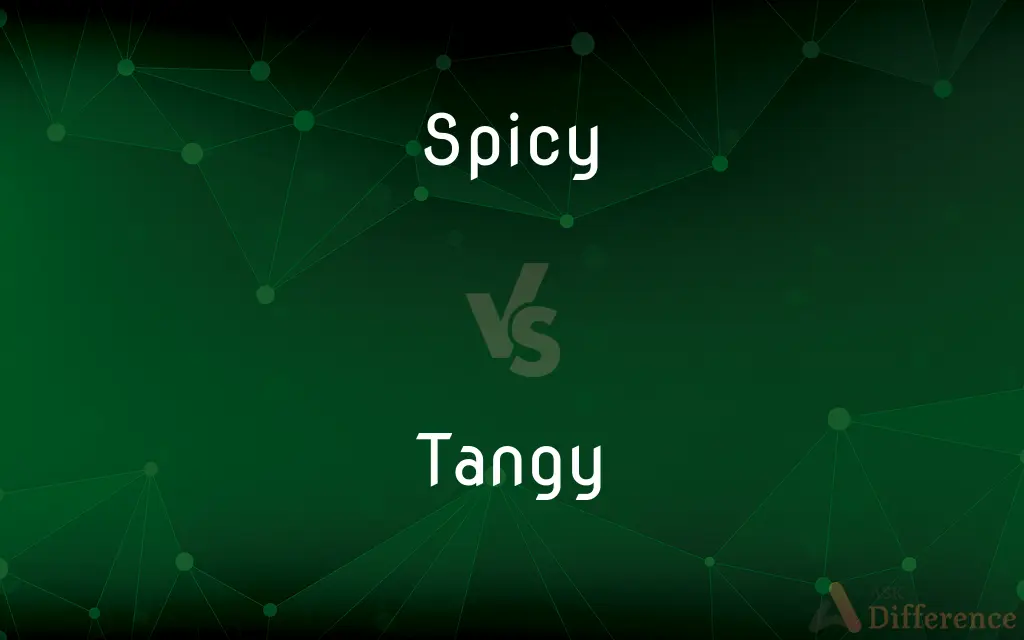Spicy vs. Tangy — What's the Difference?
By Maham Liaqat & Fiza Rafique — Updated on March 20, 2024
Spicy refers to foods with a hot, piquant flavor from peppers or spices, causing a burning sensation. Tangy foods have a sharp, often acidic taste, awakening the palate without heat.

Difference Between Spicy and Tangy
Table of Contents
ADVERTISEMENT
Key Differences
Spicy foods are characterized by their capacity to produce a warming or burning sensation in the mouth, a quality primarily attributed to the presence of compounds like capsaicin found in chili peppers or piperine in black pepper. On the other hand, tangy foods are distinguished by a sharp and slightly sour taste, often resulting from the presence of acidic components such as citric acid in lemons or acetic acid in vinegar.
While spicy flavors activate pain receptors that can lead to the feeling of heat or even pain, tangy flavors activate the sour taste receptors on the tongue, contributing to a mouth-watering effect without inducing heat. Spicy flavors are often sought after for their intensity and the way they can enhance the depth and complexity of dishes. In contrast, tanginess is appreciated for its ability to brighten and lift the flavors, adding a refreshing contrast that can balance the richness or sweetness in a meal.
The culinary use of spiciness and tanginess varies widely across cultures and cuisines. Spiciness is a hallmark of many Asian, Latin American, and African dishes, where a variety of spices and chili peppers are used to create complex flavor profiles. Meanwhile, tanginess is a characteristic feature in Mediterranean and Middle Eastern cuisines, where lemon, yogurt, and different vinegars play a crucial role in the culinary palette. These contrasting flavors contribute significantly to the diversity and richness of global food traditions.
In terms of health benefits, both spicy and tangy foods have their advantages. Spicy foods, thanks to compounds like capsaicin, have been linked to various health benefits, including improved metabolism and potential pain relief. Tangy foods, rich in vitamins and antioxidants due to their acidic nature, can aid in digestion and enhance immune function. However, the tolerance and preference for the level of spiciness or tanginess can vary greatly among individuals, influenced by cultural background, dietary habits, and personal taste.
The distinction between spicy and tangy underscores the complexity of flavor perception and the broad spectrum of tastes that contribute to our culinary experiences. Both flavors have the power to transform dishes, albeit in vastly different ways, demonstrating the intricate balance of elements that contribute to the art and science of cooking.
ADVERTISEMENT
Comparison Chart
Definition
Foods with a hot, burning sensation from spices or peppers
Foods with a sharp, slightly sour taste, often from acidic components
Primary Components
Capsaicin (chili peppers), piperine (black pepper)
Citric acid (lemons), acetic acid (vinegar)
Sensation
Activates pain receptors, causing a warming or burning sensation
Activates sour taste receptors, producing a zesty or lively flavor
Culinary Use
Key in Asian, Latin American, and African cuisines for depth and heat
Common in Mediterranean and Middle Eastern cuisines for freshness
Health Benefits
May improve metabolism, offer pain relief
Can aid digestion, enhance immune function
Examples
Chili, hot sauces, peppery dishes
Lemon juice, vinegars, dishes with a sharp acidity
Compare with Definitions
Spicy
Foods containing substances that stimulate the heat receptors.
A spicy Thai curry uses a variety of hot peppers.
Tangy
A sharp taste profile often associated with acidity.
A tangy lemon dressing adds zest to salads.
Spicy
Describes a sensation rather than a basic taste.
The spicy heat of wasabi is not just taste but also a physical feeling.
Tangy
Foods that contain natural acids, creating a vibrant flavor.
The tangy taste of yogurt is due to lactic acid.
Spicy
Often associated with specific health benefits.
Spicy food can boost metabolism due to its capsaicin content.
Tangy
Used to describe flavors that awaken the palate.
A tangy sauce made with vinegar complements fried foods.
Spicy
Flavor profile characterized by heat and a burning sensation.
Spicy chili con carne gets its kick from jalapeños.
Tangy
Indicates a slightly sour but pleasant taste.
The tangy flavor of fresh berries can enhance desserts.
Spicy
Culinary tradition that emphasizes the use of hot spices.
Sichuan cuisine is famous for its spicy dishes.
Tangy
Can offer a refreshing contrast in dishes.
Tangy flavors are used to balance the richness in creamy dishes.
Spicy
Flavoured with or fragrant with spice
Pasta in a spicy tomato sauce
Tangy
Having a strong, piquant flavour or smell
A tangy salad
Spicy
Having the flavor, aroma, or quality of spice.
Tangy
A distinctively sharp taste, flavor, or odor, as that of orange juice.
Spicy
Piquant; zesty
A spicy tomato sauce.
Tangy
A distinctive quality
"Underneath it all was the tang of genuine adventure" (Jan Clausen).
Spicy
Producing or abounding in spices.
Tangy
A sharp point, tongue, or prong.
Spicy
High-spirited; lively.
Tangy
A projection by which a tool, such as a chisel or knife, is attached to its handle or stock. Also called shank.
Spicy
Slightly scandalous; risqué
A spicy Hollywood romance.
Tangy
See surgeonfish.
Spicy
Of, pertaining to, or containing spice.
He prepared a spicy casserole.
Tangy
To furnish with a tang.
Spicy
(of flavors) Provoking a burning sensation due to the presence of chilis or similar hot spices
This curry is too spicy for me. I can't eat it.
Tangy
To give a tang to.
Spicy
(of flavors or odors) Tangy, zesty, or pungent.
She breathed in the strong, spicy aroma.
Tangy
Having a sharp, pungent flavor
Spicy
(of expression or behavior) Vigorous; colorful; stimulating.
He is known for his spicy political commentary.
Tangy
Tasting sour like a lemon
Spicy
Flavored with, or containing, spice or spices; fragrant; aromatic; as, spicy breezes.
Led by new stars, and borne by spicy gales.
Spicy
Producing, or abounding with, spices.
In hot Ceylon spicy forests grew.
Spicy
Fig.: Piquant; racy; as, a spicy debate.
Spicy
Having an agreeably pungent taste
Spicy
Having a piquant burning taste of spices or peppers;
Gingery Chinese food
Hot peppers
Hot curry
Corn chips with peppery salsa
Spicy tomato sauce
Common Curiosities
What makes food spicy?
Spiciness in food is caused by compounds like capsaicin in chili peppers, which activate the pain and heat receptors in the mouth.
How do tangy flavors enhance a dish?
Tangy flavors, often resulting from acidity, can enhance a dish by adding a lively, refreshing contrast that brightens the overall flavor profile.
Why do some people have a higher tolerance for spicy food?
Tolerance for spicy food often depends on cultural dietary habits and personal exposure; regular consumption can increase tolerance over time.
Are there health benefits to eating tangy foods?
Tangy foods, rich in acidic components, can aid in digestion, boost the immune system, and provide vitamins and antioxidants.
What's the difference between tangy and sour?
While both tangy and sour involve acidity, "tangy" often implies a sharper, more vibrant flavor that's perceived as pleasant and refreshing, whereas "sour" can denote a stronger, sometimes less pleasant acidic taste.
Is it possible to make a dish less tangy?
To make a dish less tangy, you can add sweetness or fat to balance the acidity, adjusting the flavor to your preference.
Why do spicy and tangy flavors taste different if both are often associated with heat and acidity?
Spicy and tangy flavors activate different sensory receptors—spicy flavors stimulate pain and heat receptors, while tangy flavors target sour taste receptors, leading to their distinct taste experiences.
Can a dish be both spicy and tangy?
Yes, many dishes combine spicy and tangy elements to create complex and balanced flavor profiles, such as in some Asian or Latin American cuisines.
Can people be allergic to spicy foods?
While not technically allergies, some individuals may have sensitivities to spicy foods, causing gastrointestinal or skin reactions.
How can I reduce the spiciness of a dish?
Adding dairy products, sugar, or acid can help balance and reduce the perceived spiciness of a dish.
Share Your Discovery

Previous Comparison
Laden vs. Unladen
Next Comparison
Duck vs. DockAuthor Spotlight
Written by
Maham LiaqatCo-written by
Fiza RafiqueFiza Rafique is a skilled content writer at AskDifference.com, where she meticulously refines and enhances written pieces. Drawing from her vast editorial expertise, Fiza ensures clarity, accuracy, and precision in every article. Passionate about language, she continually seeks to elevate the quality of content for readers worldwide.
















































